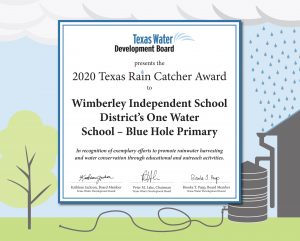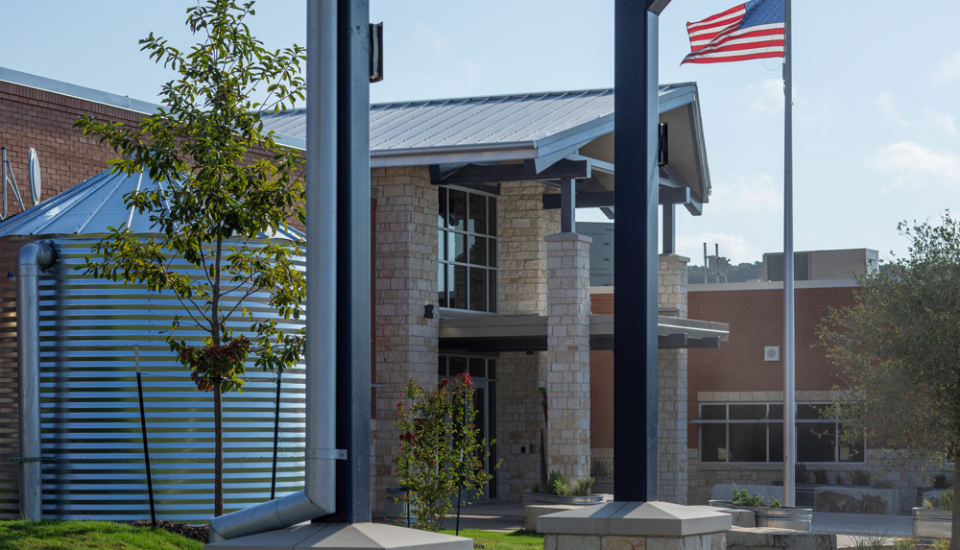One Water is defined by the Water Research Foundation (WRF) as an integrated planning and implementation approach to managing finite water resources for long-term resilience and reliability, meeting both community and ecosystem needs. It is the emerging term in the United States for what is commonly known as integrated urban water management. Given Central Texas’ population growth and limited water resources, One Water principles are becoming more and more viable options to extend and protect water supplies.
Project Highlight: Wimberley ISD’s new Blue Hole Primary campus
Using innovative one-water concepts to minimize water use and optimize onsite reuse, Wimberley Independent School District’s newest campus—Blue Hole Primary—was designed and constructed with strong support from the Wimberley Valley Watershed Association, Texas State’s Meadows Center for Water and the Environment, and the community. One Water is an intentionally integrated approach to water that promotes the management of all water—drinking water, wastewater, stormwater, graywater—as a single resource. Blue Hole Primary serves the growing Hill Country communities of Wimberley and Woodcreek with one of the most water efficient and cost-effective approaches ever envisioned for a school campus in Texas.
Video: A rain tube shows how rainwater is harvested during a storm. Rainwater and AC condensate are used in the graywater system for non-potable uses. Photo credit: Kelly F. Western, Blue Hole Primary Librarian.

The campus has 200,000 gallons of storage to hold rainwater collected from 78,000 square feet of roof and 600 to 1,300 gallons/day of AC condensate. An advanced reuse system distributes the captured rainwater and condensate to flush toilets and provide irrigation for landscaping. On-site treatment and reuse system allow gray and black water produced by the school to be beneficially reused through a subsurface drip irrigation system for a high-quality turf field.
Green stormwater infrastructure slows down runoff, decreases erosion, helps infiltration, and reduces nonpoint source pollution. Bioswales, rain gardens and walkways with permeable pavers are incorporated throughout the campus.
Blue Hole Primary’s unique campus reduces its water consumption footprint (if compared to conventional approaches) by approximately 90 percent through implementation of these one water strategies. Annual cost savings relative to standard construction and centralized water/wastewater service is expected to be between $29,000 and $48,000 per year. Total cost savings over 30 years to exceed $1,000,000 in 2018 dollars. Conservation of 237 acre-feet of groundwater over 30 years.
Groundwater from the drought-prone Trinity Aquifer provides flow to Jacob’s Well and Cypress Creek and is the sole source of drinking water for the community. Blue Hole Primary’s one water approach minimizes reliance on this stressed supply. Design and construction plans are being used to develop case studies for implementation of the holistic One Water concept and have already inspired additional projects within the region.

Central Texas’ One Water Activity
US Water Alliance’s One Water Hub including information on the annual One Water Summit. WVWA Executive Director was honored to be a part of the Austin delegation (pictured below) at the 2018 Summit. The 2019 Summit will be held in Austin.

- Mothering Earth Podcase, Episode 62 – OneWater: Fresh water is essential to all life and it is a finite resource. Most of us don’t think much about letting the water run when we wash dishes, bathe or brush our teeth. Yet, those are all examples of wasting water. In Wimberley, Texas, a new school is being built that will utilize a “one water” design. The one water concept recognizes the importance of smart water use where the building and grounds are designed to save water.
- Mothering Earth Podcast, Episode 65 – One-Water House: All water is a precious resource, including the water we use every day to flush our toilets. Low-flow toilets are designed to minimize water use, but there is also a way to design home wastewater treatment systems, that safely reuse toilet water. My guests Dr. Joan Jernigan and David Venhuizen have spent a lot of time working on this issue and are here to share their knowledge.
Useful links and resources:
-
- One Water in the Texas Hill Country: Connecting communities with Projects and Professionals (Hill Country Alliance and Texas Living Waters, 2021)
- Ensuring One Water Delivers for Healthy Waterways: A Framework for Incorporating Healthy Waterways into One Water Plans and Projects, (Texas Living Waters, 2020)
- Advancing One Water in Texas: Cynthia and George Mitchell Foundation report published in 2018.
- One Water Hub: US Water Alliance virtual gateway to connect with resources and fellow One Water leaders. Check out their resources and offerings to help shape your community’s One Water future.
- TWDB Rural Water Assistance Fund: Possible funding source for municipal and water supply projects.

